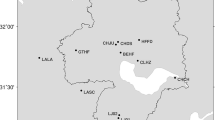Abstract
Despite its low frequency of resident earthquakes, the Korean Peninsula is indirectly affected by the large earthquakes occurring in the Japanese Islands. In this study, GPS coordinate time series were analyzed to examine the changes in the crustal movement of the Korean Peninsula due to the 2011 Tohoku-Oki (TO) earthquake. A comparison of the pre- and post-seismic crustal deformation velocities indicated that the crustal movements of the Korean Peninsula had a velocity of 29 mm/year and an azimuth of 113° before the earthquake, and a velocity of 36 mm/year and an azimuth of 108° after the earthquake. Therefore, the crustal movement velocity significantly increased, and the direction of the movement headed more eastward compared to that before the earthquake. The calculation of the progress rate of the post-seismic crustal deformation after eliminating the Euler pole velocity and annual cycle signal from the coordinate time series showed that about 80% of the total post-seismic crustal deformation had progressed in the Korean Peninsula. In addition, analysis of principal strain change indicated that for the principal strain applied to the Korean Peninsula, the east-west dilatation increased and the north-south contraction decreased compared to those in the co-seismic stage.
Similar content being viewed by others
References
Baek, J., Shin, Y.-H., Na, S.-H., Shestakov, N. V., Park, P.-H., and Cho, S. (2012). “Coseismic and postseismic crustal deformations of the Korean Peninsula caused by the 2011 Mw 9.0 Tohoku earthquake, Japan, from global positioning system data.” Terra Nova, Vol. 24, pp. 295–300, DOI: 10.1111/j.1365-3121.2012.01062.x
Feigl, K. L. and Thatcher, W. (2006). “Geodetic observations of postseismic transients in the context of the earthquake deformation cycle.” C. R. Geoscience, Vol. 338, Issues 14-15, pp. 1012–1028, DOI: 10.1016/j.crte.2006.06.006.
Gere, J. M. and Goodno, B. J. (2010). Mechanics of materials, 7th Ed., Cengage Learning, Mason, O.H., USA.
Ha, J., Park, K.-D., Won, J., and Heo, M. B. (2014). “Investigations into co-seismic deformation and strain in South Korea Following the 2011 Tohoku-oki Earthquake using GPS CORS Data.” KSCE Journal of Civil Engineering, Vol. 18, No. 2, pp. 634–638, DOI: 10.1007/s12205-014-0453-y.
Hearn, E. H. (2003). “What can GPS data tell us about the dynamics of post-seismic deformation?” Geophysical Journal International, Vol. 155, Issue 3, pp. 753–777, DOI: 10.1111/j.1365-246X.2003.02030.x.
Jin, S. and Park, P.-H. (2006). “Strain accumulation in South Korea inferred from GPS measurements.” Earth Planets Space, Vol. 58, No. 5, pp. 529–534.
JPL ftpsite (2011). <ftp://sideshow.jpl.nasa.gov/pub/usrs/ARIA/ARIA_co_ and_postseismi c_V0.3.pdf>.
KMA website (2014}). <http://www.kma.go.kr/weather/earthquake>
Lyard, F., Lefevre, F., Letellier, T., and Francis, O. (2006). “Modelling the global ocean tides: Modern insights from FES2004.” Ocean Dynamics, Vol. 56, Nos. 5-6, pp. 394–415.
Marone, C., Scholz, C., and Bilham, R. (1991). “On the mechanics of earthquake afterslip.” Journal of Geophysical Research: Solid Earth, Vol. 96, Issue B5, pp. 8441–8452, DOI: 10.1029/91JB00275.
NGII (2007). A study of the crustal deformation of the Korean Peninsula, No. 1-1500714-000054-01, National Geographic Information Institute, Korea. pp. 37–94.
NGII (2014). NGII Notification, National Geographic Information Institute, Ministry of Land, Transport and Maritime Affairs, Notification 2014-164 and 2014-165.
Ozawa, S., Nishimura, T., Munekane, H., Suito, H., Kobayashi, T., Tobita, M., and Imakiire, T. (2012). “Preceding, coseismic, and postseismic slips of the 2011 Tohoku earthquake, Japan.” Journal of Geophysical Research, Vol. 117, Issue B07404, DOI: 10.1029/2011JB009120.
Park, K.-D. and Won, J. (2010). “The foliage effect on the height time series from permanent GPS stations.” Earth Planets Space, Vol. 62, No. 11, pp. 849–856, DOI: 10.5047/eps.2010.10.005.
Reid, H. F. (1910). “The Mechanics of the Earthquake, The California Earthquake of April 18, 1906.” Report of the State Investigation Commission, Vol. 2, Carnegie Institution of Washington, Washington, D.C.
Wang, M., Li, Q., Wang, F., Zhang, R., Wang, Y. Z., Shi, H. B., Zhang, P. Z., and Shen, Z. K. (2011). “Far-field coseismic displacements associated with the 2011 Tohoku-oki earthquake in Japan observed by Global Positioning System.” Chinese Science Bulletin, Geophysics, Vol. 56, No. 23, pp. 2419–2424.
Webb, F. H. and Zumberge, J. F. (1993). An introduction to the GIPSY/OASIS-II, JPL Publ., Pasadena, C.A., USA.
Wübbena, G., Schmitz, M., Menge, F., Boder, V., and Seeber, G. (2000). “Automated absolute field calibration of GPS antennas in realtime.” Proc., 13th. Int. Tech. Meeting of the Satellite Division of the Institute of Navigation ION GPS 2000, Salt Lake City, U.T., USA., pp. 2512–2522.
Author information
Authors and Affiliations
Corresponding author
Rights and permissions
About this article
Cite this article
Kim, D., Park, KD., Ha, J. et al. Geodetic analysis of post-seismic crustal deformations occurring in South Korea due to the Tohoku-Oki earthquake. KSCE J Civ Eng 20, 2885–2892 (2016). https://doi.org/10.1007/s12205-016-0086-4
Received:
Accepted:
Published:
Issue Date:
DOI: https://doi.org/10.1007/s12205-016-0086-4




